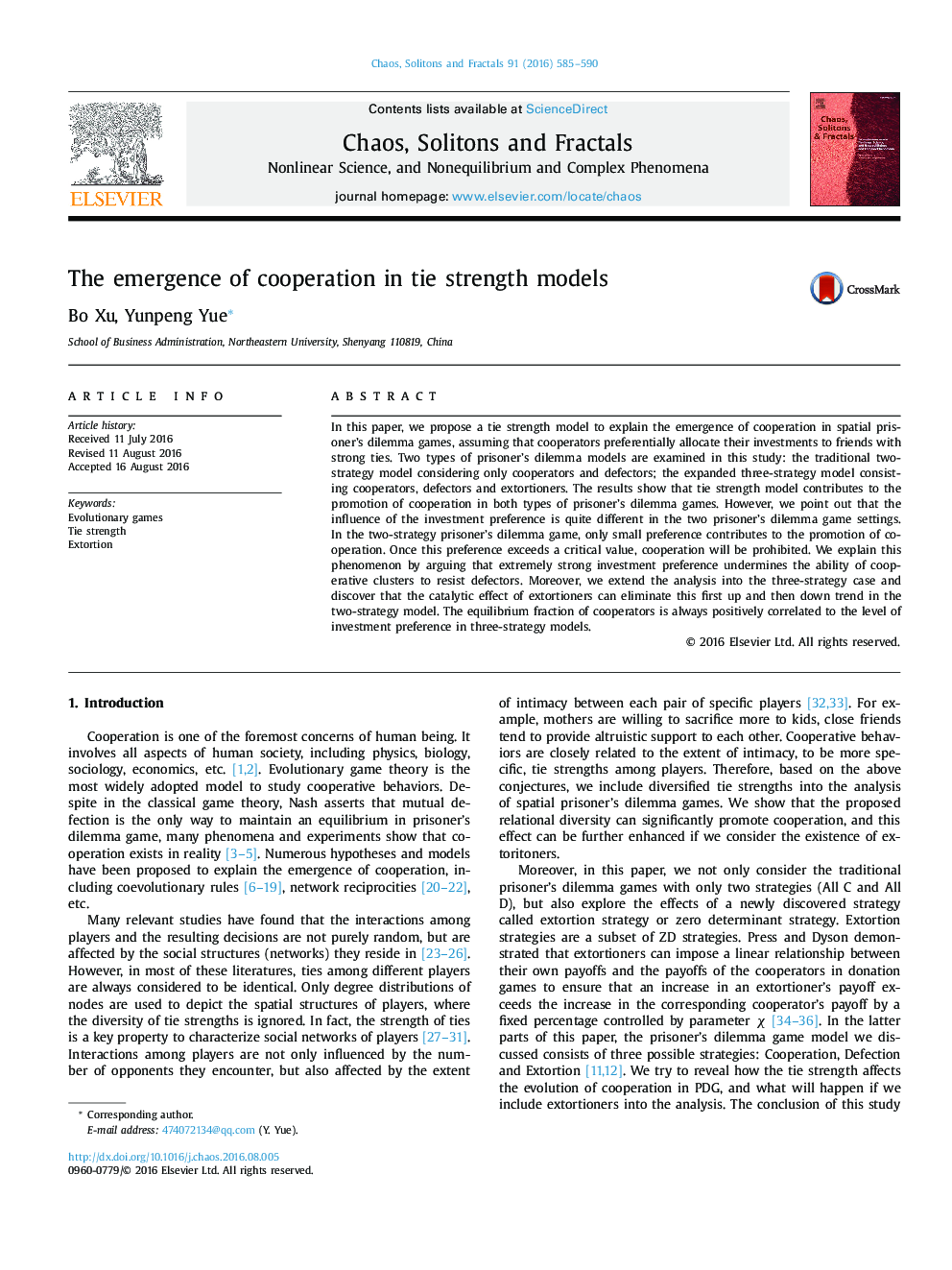| کد مقاله | کد نشریه | سال انتشار | مقاله انگلیسی | نسخه تمام متن |
|---|---|---|---|---|
| 8254676 | 1533634 | 2016 | 6 صفحه PDF | دانلود رایگان |
عنوان انگلیسی مقاله ISI
The emergence of cooperation in tie strength models
ترجمه فارسی عنوان
ظهور همکاری در مدل های قدرت کراوات
دانلود مقاله + سفارش ترجمه
دانلود مقاله ISI انگلیسی
رایگان برای ایرانیان
کلمات کلیدی
بازی های تکاملی، قدرت اتصال اخاذی،
ترجمه چکیده
در این مقاله، ما پیشنهاد می کنیم یک مدل قدرت کافی برای توضیح ظهور همکاری در بازی های معضل زندانی فضایی، فرض کنیم که همکاران به ترتیب سرمایه گذاری خود را به دوستان با روابط قوی اختصاص می دهند. در این تحقیق، دو نوع مدل معضل زندانی مورد بررسی قرار گرفته است: مدل دوسنتی استراتژیک سنتی با توجه به همکاری و تعصب؛ مدل سه استراتژی توسعه یافته متشکل از همکاران، متخلفان و ستیزه جویان است. نتایج نشان می دهد که مدل قدرت کراوات در ارتقاء همکاری در هر دو نوع بازی های معضل زندانی نقش دارد. با این حال، ما اشاره می کنیم که تأثیر اولویت سرمایه گذاری در تنظیمات بازی دو بازیکن زندان کاملا متفاوت است. در بازی معضل زندانی دو استراتژی، تنها اولویت های کوچک به ارتقاء همکاری کمک می کند. هنگامی که این ترجیح بیش از یک ارزش بحرانی باشد، همکاری ممنوع است. ما این پدیده را توضیح می دهیم با این استدلال که اولویت سرمایه گذاری بسیار شدید توانایی خوشه های تعاونی را برای مقاومت در برابر نقصانگرها تضعیف می کند. علاوه بر این، ما تجزیه و تحلیل را به پرونده سه استراتژی گسترش می دهیم و کشف می کنیم که اثر کاتالیزوری جرایم مزاحم می تواند این روند را در ابتدا و سپس در مدل دو استراتژی حذف کند. تعادل تعادلی همکاران همیشه با سطح اولویت سرمایه گذاری در مدل سه استراتژی رابطه مثبت دارد.
موضوعات مرتبط
مهندسی و علوم پایه
فیزیک و نجوم
فیزیک آماری و غیرخطی
چکیده انگلیسی
In this paper, we propose a tie strength model to explain the emergence of cooperation in spatial prisoner's dilemma games, assuming that cooperators preferentially allocate their investments to friends with strong ties. Two types of prisoner's dilemma models are examined in this study: the traditional two-strategy model considering only cooperators and defectors; the expanded three-strategy model consisting cooperators, defectors and extortioners. The results show that tie strength model contributes to the promotion of cooperation in both types of prisoner's dilemma games. However, we point out that the influence of the investment preference is quite different in the two prisoner's dilemma game settings. In the two-strategy prisoner's dilemma game, only small preference contributes to the promotion of cooperation. Once this preference exceeds a critical value, cooperation will be prohibited. We explain this phenomenon by arguing that extremely strong investment preference undermines the ability of cooperative clusters to resist defectors. Moreover, we extend the analysis into the three-strategy case and discover that the catalytic effect of extortioners can eliminate this first up and then down trend in the two-strategy model. The equilibrium fraction of cooperators is always positively correlated to the level of investment preference in three-strategy models.
ناشر
Database: Elsevier - ScienceDirect (ساینس دایرکت)
Journal: Chaos, Solitons & Fractals - Volume 91, October 2016, Pages 585-590
Journal: Chaos, Solitons & Fractals - Volume 91, October 2016, Pages 585-590
نویسندگان
Xu Bo, Yue Yunpeng,
